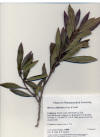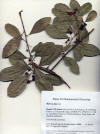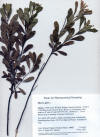|
Myrica californica |
Myrica californica |
|
Myrica faya
|
Myrica gale
|
|
Myrica
cerifera Cheng H. Y., T. C. Lin, K. Ishimaru, C. M. Yang, K. C. Wang and C. C. Lin. 2003. In vitro antiviral activity of prodelphinidin B-2 3,3'-di-O-gallate from Myrica rubra. Planta Med. 69(10): 953–956. “In this study, the in vitro antiviral properties of prodelphinidin B-2 3,3'-di- O-gallate (PB233'OG) isolated from the bark of Myrica rubra (Myricaceae) was investigated. Results showed that PB233'OG exhibited anti-herpes simplex virus type 2 (HSV-2) activity with IC (50) values of 5.3 +/- 0.1 and 0.4 +/- 0.04 microM for XTT and plaque reduction assays, respectively. The IC (50) value increased with increasing MOI (multiplicity of infection). PB233'OG did not show a cellular cytotoxic effect at concentrations that possessed antiviral activity. Mechanistic studies demonstrated that PB233'OG inhibited HSV-2 attachment to the Vero cell, interfered with the penetration of HSV-2 into the Vero cell, affected the late stage(s) of the HSV-2 infection cycle, and also reduced the viral infectivity at high concentrations. It is concluded that PB233'OG exhibits various modes of action in its anti-HSV-2 effects.” Gafner S., J. L. Wolfender, S. Mavi and K. Hostettmann. 1996. Antifungal and antibacterial chalcones from Myrica serrata. Planta Med. 62(1): 67–69. “The dichloromethane extract of the leaves of Myrica serrata inhibits growth of Cladosporium cucumerinum, Bacillus subtilis, and Escherichia coli on TLC plates. Activity-guided fractionation led the isolation of 2',4'-dihydroxy-6'-methoxy-3',5'-dimethylchalcone (1), 2',4'-dihydroxy-6'-methoxy-5'-methylchalcone (aurentiacin A) (2), 2',6'-dihydroxy-4'-methoxy-3',5'-dimethyldihydrochalcone (3), 2'-hydroxy-4',6'-dimethoxy-3'-methyldihydrochalcone (4), and 2', 6'-dihydroxy-4'-methoxy-3'-methyldihydrochalcone (5). In addition, the flavanones demethoxymatteucinol (6) and cryptostrobin (7) were also identified.” Inoue T., Y. Arai and M. Nagai. 1984. Diarylheptanoids in the bark of Myrica rubra Sieb. et Zucc. Yakugaku Zasshi. 104(1): 37–41. In Japanese. Matsuda H, T. Morikawa, J. Tao, K. Ueda and M. Yoshikawa. 2002. Bioactive constituents of Chinese natural medicines. VII. Inhibitors of degranulation in RBL-2H3 cells and absolute stereostructures of three new diarylheptanoid glycosides from the bark of Myrica rubra. Chem. Pharm. Bull. (Tokyo) 50(2): 208–215. “Three new diarylheptanoid glycosides, named (+)-S-myricanol 5-0-beta-D-glucopyranoside, myricanene A 5-O-alpha-L-arabinofuranosyl(1-->6)-beta-D-glucopyranoside, and myricanene B 5-0-alpha-L-arabinofuranosyl(1-->6)-beta-D-glucopyranoside, were isolated from the bark of Chinese Myrica rubra, together with twenty known compounds. The absolute stereostructures of the new diarylheptanoid glycosides were elucidated on the basis of chemical and physicochemical evidence, including the application of the modified Mosher's method. The inhibitory effects of isolated constituents on the release of beta-hexosaminidase from RBL-2H3 cells were examined, and several diarylheptanoids, myricanol, (+)-S-myricanol, myricanone, and myricanenes A and B, and a flavonol, myricetin, were found to show the inhibitory activity.” Matsuda H., M. Yamazaki, K. Matsuo, Y. Asanuma and M. Kubo. 2001. Anti-androgenic activity of Myricae Cortex--isolation of active constituents from bark of Myrica rubra. Biol. Pharm. Bull. 24(3): 259–263. “The aqueous ethanol extract of Myricae Cortex (bark of Myrica rubra Sieb. et Zucc., Myricaceae) showed in vitro testosterone 5alpha-reductase inhibitory activity and in vivo anti-androgenic activity using growth of flank organ in castrated Syrian hamsters and/or hair regrowth after shaving in testosterone-treated C57Black/6CrSlc mice. Three constituents, myricanone, myricanol, and myricetin were identified as the main active principles.” Njung'e K., G. Muriuki, J. W. Mwangi and K. A. Kuria. 2002. Analgesic and antipyretic effects of Myrica salicifolia (Myricaceae). Phytother. Res. 16 Suppl 1: S73–74. “Myrica salicifolia Hoechst (Myricaceae) root extract was found to have analgesic activity in mice. In rats there was antipyretic but no antiinflammatory activity. ” Sylvestre M., J. Legault, D. Dufour and A. Pichette. 2005. Chemical composition and anticancer activity of leaf essential oil of Myrica gale L. Phytomedicine. 2005 Apr;12(4):299-304. “Myrica gale L. (Myricaceae), a native plant from Canada used in traditional medicine, was extracted by hydrodistillation and the oil was collected after 30 and 60 min. The chemical composition of these two extracts was determined using GC-MS analysis. We identified 53 components and myrcene (23.18-12.14%), limonene (11.20-6.75%), alpha-phellandrene (9.90-6.49%) and beta-caryophyllene (9.31-10.97%) were the major components in the 30- and 60-min fractions, respectively, whereas higher caryophyllene oxide content was detected in the 60-min fraction (9.94%) than in the 30-min fraction (3.47%). The anticancer activities of these extracts were assessed against human lung carcinoma cell line A-549 and human colon adenocarcinoma cell line, DLD-1. The 60-min fraction showed higher anticancer activity against both tumor cell lines with an IC50 value of 88 +/- 1 microg/ml. The 30-min fraction had an IC50 value of 184 +/- 4 microg/ml for A-549 and 160 +/- 3 microg/ml for DLD-1. The higher cell growth inhibition induced by the 60-min fraction, as compared to the 30-min fraction, could be due to sesquiterpene enrichment.”
Yang L.L., C.
C. Chang, L. G. Chen and C. C. Wang. 2003. Antitumor principle
constituents of Myrica rubra var. acuminata. J. Agric. Food
Chem. 51(10): 2974–2979. “Myrica rubra var.
acuminata is a native shrub widely distributed and used as folk
medicine in Taiwan for stomach disorders and diarrhea. Column
chromatography combined with cytotoxic bioassay-guided fractionation was
performed to isolate the antitumor principles from fresh leaves of M.
rubravar. acuminata. The 20% MeOH eluate fraction of M. rubra var.
acuminata inhibited the viability of HeLa and P-388 cells in an in vitro
assay and an in vivo P-388 tumor-bearing CDF(1) mouse model. The percent
increase in life span (%ILS) of 20% MeOH eluate fraction was greater than
125%. (-)-Epigallocatechin 3-O-gallate (1) and prodelphinidin
A-2,3'-O-gallate (2) were isolated from D-20 as the antitumor principle
components. Both compounds can inhibit the growth of HeLa cells, but 1 had
lower cytotoxic effects in normal cervical fibroblasts than did 2.
Moreover, pretreatment with a caspase-3 specific inhibitor prevented 1-
and 2-induced poly(ADP-ribose) polymerase cleavage. In view of these
results, we suggest that 1 and 2 can induce apoptosis in HeLa cells and
that activation of caspase-3 may provide a mechanistic explanation for
their cytotoxic effects. Therefore, we suggest that the 20% MeOH eluate
fraction extract is good for health and that M. rubra var. acuminata is an
economically valuable plant.”
|
|



